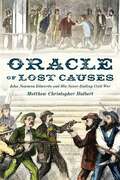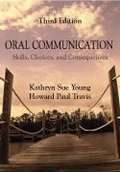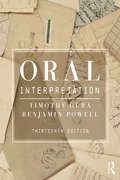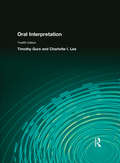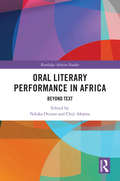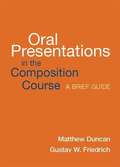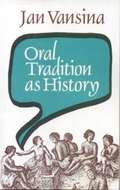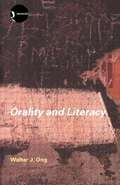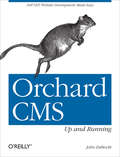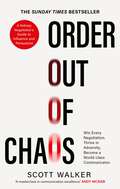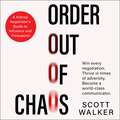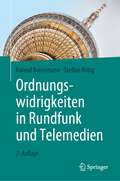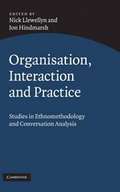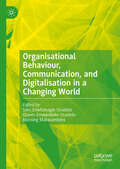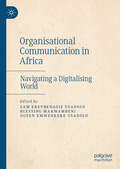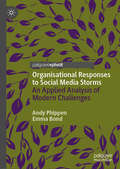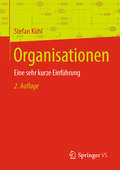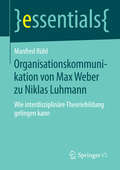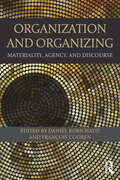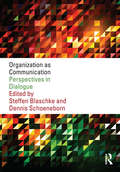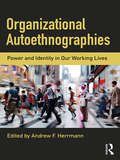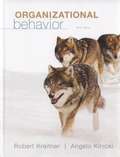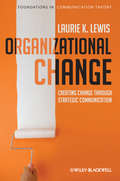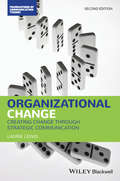- Table View
- List View
Oracle of Lost Causes: John Newman Edwards and His Never-Ending Civil War
by Matthew Christopher HulbertJohn Newman Edwards was a soldier, a father, a husband, and a noted author. He was also a virulent alcoholic, a duelist, a culture warrior, and a man perpetually at war with the modernizing world around him. From the sectional crisis of his boyhood and the battlefields of the western borderlands to the final days of the Second Mexican Empire and then back to a United States profoundly changed by the Civil War, Oracle of Lost Causes chronicles Edwards&’s lifelong quest to preserve a mythical version of the Old World—replete with aristocrats, knights, damsels, and slaves—in North America. This odyssey through nineteenth-century American politics and culture involved the likes of guerrilla chieftains William Clarke Quantrill and &“Bloody Bill&” Anderson, notorious outlaws Frank and Jesse James, Confederate general Joseph Orville Shelby, and even Emperor Maximilian I and Empress Charlotte of Mexico. It is the story of a man who experienced Confederate defeat not once but twice, and how he sought to shape and weaponize the memory of those grievous losses. Historian Matthew Christopher Hulbert ultimately reveals how the Civil War determined not only the future of the vast West but also the extent to which the conflict was part of a broader, international sequence of sociopolitical uprisings.
Oral Communication: Skills, Choices, and Consequences
by Kathryn Sue Young Howard Paul TravisThis book is designed to help you recognize the importance of your words and actions in communication. The goals for this undergraduate communication textbook are to: (1) engage you to think about the skills, choices, and consequences of your communication; (2) create a book you will want to read; and (3) convince you that success can be yours if you make solid choices in your communication style.
Oral Interpretation (Mysearchlab Series 15% Off Ser.)
by Benjamin Powell Timothy GuraIn its 13th Edition, the iconic Oral Interpretation continues to prepare students to analyze and perform literature through an accessible, step-by-step process. New selections join classic favorites, and chapters devoted to specific genres—narrative, poetry, group performance, and more—explore the unique challenges of each form. Now tighter and more focused than its predecessors, this edition highlights movements in contemporary culture—especially the contributions of social media to current communication. New writings offer advice and strategies for maximizing body and voice in performance, and enhanced devices guide novices in performance preparation.
Oral Interpretation (Mysearchlab Series 15% Off Ser.)
by Timothy Gura Charlotte LeeFor over fifty years, Oral Interpretation has successfully prepared students to analyze and perform literature through an accessible, step-by-step process. The authors classic commitment to helping students understand literature then to embody and evoke the work has been refined to offer students a more concise, user-friendly process that will help them succeed in their daunting first performance. Updated with a tightly edited collection of classic and contemporary selections, each chapter provides a wide variety of selections for students at all levels. Chapters devoted to each genre---narrative, poetry, drama, group performance–explore the unique challenges of each form while newly revised chapters on Using the Body and Using the Voice in performance introduce students to technical exercises to promote performance flexibility.
Oral Literary Performance in Africa: Beyond Text (Routledge African Studies)
by Nduka Otiono and Chiji AkọmaThis book delivers an admirably comprehensive and rigorous analysis of African oral literatures and performance. Gathering insights from distinguished scholars in the field, the book provides a range of contemporary interdisciplinary perspectives in the study of oral literature and its transformations in everyday life, fiction, poetry, popular culture, and postcolonial politics. Topics discussed include folklore and folklife; oral performance and masculinities; intermediated orality, modern transformations, and globalization; orality and mass media; spoken word and imaginative writing. The book also addresses research methodologies and the thematic and theoretical trajectories of scholars of African oral literatures, looking back to the trailblazing legacies of Ruth Finnegan, Harold Scheub, and Isidore Okpewho. Ambitious in scope and incisive in its analysis, this book will be of interest to students and scholars of African literatures and oral performance as well as to general readers interested in the dynamics of cultural production.
Oral Presentations in the Composition Course: A Brief Guide
by Matthew Duncan Gustav W. FriedrichThe ideal supplement for any writing class that includes an oral component, Oral Presentations in the Composition Course: A Brief Guide offers students the advice they need to plan, prepare, and present their work effectively. With sections on analyzing audiences, choosing effective language, using visual aids, collaborating on group presentations, and dealing with the fear of public speaking, this booklet offers help for students' most common challenges in developing oral presentations.
Oral Tradition as History
by Jan VansinaAlthough written by a leading historian of Africa, Vansina's work on oral traditions ranges far beyond Africa, so has a wider relevance. Vansina explains not only how oral traditions have been used in the past but also how they should be used by historians in their research.
Orality and Literacy: The Technologizing of the Word
by Walter J. OngThis classic work explores the vast differences between oral and literate cultures and offers a brilliantly lucid account of the intellectual, literary and social effects of writing, print and electronic technology.
Orchard CMS: ASP.NET Website Development Made Easy
by John ZablockiUse your C# skills to build your next website with Orchard, the popular content management system based on ASP.NET MVC. With step-by-step guidance, you’ll learn your way around the Orchard environment by constructing a complete, real-world site throughout the course of this book. You’ll create, manage, and display dynamic content with out-of-the-box functionality, and then build themes, modules, and widgets to customize the site.Author John Zablocki gets you started by showing you how to obtain and compile the Orchard source code, so you can more efficiently customize and manage the sites you create.Create or extend Orchard content types to manage dynamic contentUse alternate templates to change the way Orchard displays contentDesign a theme to define your website’s look and feelBuild custom modules when the Orchard Gallery doesn’t have extensions you needCreate reusable content pieces by creating widgetsExplore options for adding multi-language support to a siteLearn hosting options for your Orchard sites, including the cloudPackage your custom themes and modules to share in Orchard Gallery
Order Out of Chaos: A Kidnap Negotiator's Guide to Influence and Persuasion
by Scott WalkerA new approach to succeeding in negotiations where failure is not an option, from one of the world's most experienced kidnap for ransom negotiators.Scott Walker has probably one of the most difficult jobs in the world. When pirates have hijacked a ship, when a criminal gang has kidnapped someone, when an entire company's future is being held to ransom from a cyber-attack, Scott is the person who gets called in. He has successfully negotiated more than 300 such incidents using the principles in this book.His methods, centred in empathy, active listening, trust-based influence and emotional control, will help you achieve the outcome you want. Regardless of whether you're an executive in a multi-national organisation, the owner of a small business, a local sports team coach or running the family household, you're negotiating every single day, whether you realise it or not.Learn the skills Scott uses to resolve life or death kidnappings all over the world - from the Niger Delta, China and the Philippines to the Middle East, Europe and Latin America - and how to apply them to your own life, at work and at home.Order Out of Chaos provides tools that cut straight to the most effective way of communicating, particularly in times of crisis, change and uncertainty.
Order Out of Chaos: A Kidnap Negotiator's Guide to Influence and Persuasion. The Sunday Times bestseller
by Scott WalkerThe indispensable Sunday Times bestselling guide to succeeding in negotiations where failure is not an option, from one of the world's most experienced kidnap for ransom negotiators.Scott Walker has probably one of the most difficult jobs in the world. When pirates have hijacked a ship, when a criminal gang has kidnapped someone, when an entire company's future is being held to ransom from a cyber-attack, Scott is the person who gets called in. He has successfully negotiated more than 300 such incidents using the principles in this book.His methods, centred in empathy, active listening, trust-based influence and emotional control, will help you achieve the outcome you want. Regardless of whether you're an executive in a multi-national organisation, the owner of a small business, a local sports team coach or running the family household, you're negotiating every single day, whether you realise it or not.Learn the skills Scott uses to resolve life or death kidnappings all over the world - from the Niger Delta, China and the Philippines to the Middle East, Europe and Latin America - and how to apply them to your own life, at work and at home.Order Out of Chaos provides tools that cut straight to the most effective way of communicating, particularly in times of crisis, change and uncertainty.
Ordnungswidrigkeiten in Rundfunk und Telemedien
by Roland Bornemann Steffen RittigDas Rechtshandbuch stellt die Ahndung und Verfolgung von Ordnungswidrigkeiten in Online-Medien (Rundfunk und Telemedien) mit ihren Besonderheiten dar. Es konzentriert sich auf die Gesichtspunkte, die in der Praxis eine Rolle spielen. Damit versetzt es Leser in die Lage, einen durchschnittlichen Alltagsfall im rundfunkrechtlichen Bußgeldverfahren ohne weitere Spezialliteratur zu lösen. Das Werk ist unverzichtbar für die Compliance bei privaten Rundfunkveranstaltern, Anbietern von rundfunkähnlichen Telemedien, Medienplattformen, Benutzeroberflächen, Medienintermediären und sonstigen Telemedien. Es wendet sich zudem an Studierende mit medienrechtlichem Studienschwerpunkt, an Landesmedienanstalten als nach §§ 35, 36 OWiG zuständige Verwaltungsbehörden sowie an Staatsanwaltschaften und Strafgerichte, aber ebenso und nicht zuletzt an die Verteidigerinnen und Verteidiger im Bußgeldverfahren.
Organisation, Interaction and Practice
by Nick Llewellyn Jon HindmarshEthnomethodology has an elusive relationship with organisation studies. The ethnomethodological work of Harold Garfinkel, and the allied conversation analytic work of Harvey Sacks, is often cited and yet empirical contributions informed by ethnomethodology and conversation analysis remain rare. Organisation studies clearly has a lot to say about work but this is normally related to some broader set of social, economic and political issues. Rarely, if ever, does this research involve an analysis of the mundane and practical details of what actual work consists of. This book acts as an evidence-based corrective by showing how research based on ethnomethodology and conversation analysis can contribute to key issues and debates in organisation studies. Drawing on audio/video recordings from a diverse range of work settings, a team of leading scholars present a series of empirical studies that illustrate the importance of paying attention to the real-time achievement of organisational processes and practices.
Organisational Behaviour, Communication, and Digitalisation in a Changing World
by Sam Erevbenagie Usadolo Blessing Makwambeni Queen Emwenkeke UsadoloThis book brings together leading scholars and practitioners in organizational behaviour and communication to explore the complex relationship between employees and their organisations and the associated workplace outcomes. This comprehensive volume provides insights, theories, and practical strategies to understand and address the multifaceted nature of organisational dynamics in the face of constant and accelerated change. The first section of the book delves into the theoretical foundations of organisational behaviour. Some of the contributors in this section offer a comprehensive analysis of the socio-cultural and psychological aspects that influence individual behaviour within organisations. Building upon this foundation, the subsequent sections of the book examine various dimensions of organisational behaviour, including leadership, teamwork, diversity, and conflict resolution. One of the focuses of this edited volume is the examination of emerging technologies and their effects on the operation of organisations. Hence, some of the chapters examine the management of employee-organisations using digital platforms and explore employee engagement, collaboration, the effect of organisational support, supervisor support, or lack thereof. By delving into the role of digital technologies in the context of a changing world, the book offers valuable insights into the development of contemporary organisations, especially how technology is leveraged to foster a sense of connectivity in dispersed work environments.
Organisational Communication in Africa: Navigating a Digitalising World
by Sam Erevbenagie Usadolo Blessing Makwambeni Queen Emwenkeke UsadoloThis book delves comprehensively into organisational communication in Africa in the digital age, alongside other organisational changes. This makes it a valuable resource for scholars, practitioners, and students in organisational communication, corporate communication, public relations, and development communication – both within Africa and across the globe. Through diverse perspectives and evidence-based insights, the book equips readers with the knowledge and tools needed to navigate the ever-changing organisational landscape and achieve success in our rapidly evolving world.
Organisational Responses to Social Media Storms: An Applied Analysis of Modern Challenges
by Andy Phippen Emma BondThis book explores the growing phenomenon of the social media storm in the context of educational establishments. With a methodological approach that draws on aspects of virtual and offline ethnography, the text presents a series of case studies of public online risk-related incidents. Our ethnographic methodology adopts the use of unobtrusive data collection approaches, to explore publicly available data from online interactive behaviours. Drawing on a range of methods from internet mediated research (IMR) to inform our ethnographic account, the book provides an in-depth exploration of the public and organisational discourses arising from four short, clear high-profile internet risk case studies in the education sector ranging from early year to higher education. It considers the social construction of a new ‘risk’ culture arising computer-mediated social interactions and its impact on, and response by, the organisations and society.
Organisationen: Eine sehr kurze Einführung
by Stefan KühlVon der Wiege bis zur Bahre wird unser Leben durch Organisationen bestimmt. Aber wir sind nicht dafür ausgebildet worden, wie wir als Mitglied mit Unternehmen, Verwaltungen, Universitäten, Schulen, Krankenhäusern, Gefängnissen, Parteien oder Armeen zurechtkommen können. Organisationen – was sind das für „Gebilde“, die unsere moderne Gesellschaft so stark bestimmen? Wie "ticken" sie? Welche Eingriffsmöglichkeiten gibt es? Anhand der drei zentralen Merkmale Zwecke, Hierarchie und Mitgliedschaften wird grundlegend erklärt, wie Organisationen funktionieren.
Organisationskommunikation von Max Weber zu Niklas Luhmann: Wie interdisziplinäre Theoriebildung gelingen kann (essentials)
by Manfred RühlSeit ihren Anfängen stellt die Kommunikationswissenschaft die menschliche Kommunikation [human communication] in den Mittelpunkt (Dance, 1967; A. G. Smith, 1966; Schramm, 1980). Der Begriff Organisation ist seit dem 19. Jahrhundert in sozialwissenschaftlichem Gebrauch (Luhmann, 1964). Für Probleme der Organisationskommunikation [organizational communication] erstellt W. Charles Redding (1972) einen ersten Forschungsüberblick, und Karlene H. Roberts et al. (1974, S. 501) konstatieren: "Organizational communication appears to be in an identity crisis. " Üblicherweise werden Anfänge der Organisationskommunikation mit Messungen organisatorischer Arbeit in Industriebetrieben durch die Ingenieure Frederick W. Taylor (1911) und Henri Fayol (1916) in Zusammenhang gebracht. Die junge deutsche Betriebswirtschaftslehre (Plenge, 1919) suchte nach der richtigen Betriebsführung [management], und die sozialpsychologisch-empirisch operierenden Hawthorne-Studien (Mayo, 1933; Roethlisberger & Dickson, 1939) experimentierten in tayloristisch bestimmten Arbeitsorganisationen. Mit seiner Bürokratieforschung eröffnete Max Weber (1922) das Theoretisieren über sinnmachendes Handeln rationaler Organisation. Mary Parker Follett (1941), Chester I. Barnard (1938, 1948) und Herbert A. Simon (1945, 1958) problematisierten Verbindungen zwischen Organisation, Entscheidung und Kommunikation. Und Niklas Luhmann (2000) empfahl, die Organisation nicht länger als eine, durch Hierarchie und Zweck/Mittel-Beziehungen strukturierte Gegebenheit hinzunehmen, vielmehr ein autopoietisches System zu rekonstruieren, das sich durch Kommunikation und Entscheidungsprogramme selbst reproduziert. Im deutschen Sprachraum setzt sich die Journalismusforschung am ehesten mit dieser Entwicklung auseinander.
Organization and Organizing: Materiality, Agency and Discourse
by François Cooren Daniel RobichaudRecipient of the '2013 Top Edited Book Award', by the Organizational Communication Division of the National Communication Association (USA) This timely collection addresses central issues in organizational communication theory on the nature of organizing and organization. The unique strength of this volume is its contribution to the conception of materiality, agency, and discourse in current theorizing and research on the constitution of organizations. It addresses such questions as: To what extent should the materiality of texts and artifacts be accounted for in a process view of organization? What part does materiality play in the process by which organizations achieve continuity in time and space? In what sense do artifacts perform a role in human communication and interaction and in the constitution of organization? What are the voices and entities participating in the emergence and stabilization of organizational reality? The work represents scholarship going on in various parts of the world, and features contributions that overcome traditional conceptions of the nature of organizing by addressing in specific ways the difficult issues of the performative character of agency; materiality as the basis of the iterability of communication and continuity of organizations; and discourse as both textuality and interaction. The contributions laid out in this book also pay tribute to the work of the organizational communication theorist James R. Taylor, who developed a view of organization as deeply rooted in communication and language. Contributors extend and challenge Taylor’s communicative view by tackling issues and assumptions left implicit in his work.
Organization as Communication: Perspectives in Dialogue
by Dennis Schoeneborn Steffen BlaschkeThe idea that communication constitutes organization (CCO) provides a unique perspective to organization studies by highlighting the fundamental and formative role of communication for organizational phenomena of various kinds. The book features original works that address the idea of organization as communication in the light of other theories, related concepts, as well as the tension between strategy and emergence. The first set of chapters discusses the idea of organization communication in the light of critical works of European scholars (Habermas, Honneth, and Günther). The second set of chapters reflects on a range of concepts such as institutions, routines, and leadership from a CCO perspective. The final set of chapters examines the tension between strategic and emergent communication by drawing on new methodology and empirical evidence. The chapters are set into dialogue with some of the most prominent proponents of CCO scholarship. The book offers an important contribution to CCO thinking by adding European perspectives on organization as communication. It connects the primarily North American approach and European traditions of theoretical thought to existing debates in communication and organization studies.
Organizational Autoethnographies: Our Working Lives
by Andrew HerrmannThis text takes a new approach to autoethnography by using personal narratives to analyze our work across multiple disciplines and subdisciplines. These stories feature authors working at the intersections of autoethnography and critical theory within a given organizational context. Organizations are not simply entities, but systems of meaning. As such they are sites of cultural practices and performances, and of domination, resistance and struggle.? Working at the intersection of organizational studies and autoethnography, this book explores the ability of autoethnographic and personal narrative approaches to generate important, innovative, and empowering understandings of difference, discourses, and identities, while attending to the various powerful dynamics that are at play in organizations. These are stories of work, at work, and help to finally bring theory and direct exemplars together.
Organizational Behavior
by Angelo Kinicki Robert KreitnerIn its tradition of being an up-to-date, relevant and user-driven textbook, Kreitner and Kinicki's approach to organizational behavior is based on the authors' belief that reading a comprehensive textbook is hard work; however, the process should be interesting and sometimes even fun. The authors' commitment to continuous improvement makes complex ideas understandable through clear and concise explanations, contemporary examples, a visually appealing photo/art program, and/or learning exercises. The authors respond to user feedback by ensuring the text covers the very latest OB research and practices.
Organizational Behavior Reading: Negotiation
by Max Bazerman Francesca Gino Katherine ShonkCore Curriculum in Organizational Behavior is a series of readings that cover fundamental course material in Organizational Behavior. Readings include videos and interactive illustrations to help students master complex concepts. Managerial, executive, and entrepreneurial success requires the ability to negotiate. The essential reading and recommended module plan will help students to become more effective negotiators by: 1) mastering a negotiation framework that will help them analyze, prepare for, and execute negotiations more systematically—and hence, more effectively—in a wide variety of contexts; 2) building a negotiation toolkit that consists of practical strategies for creating and capturing value in negotiation; and 3) learning how to create a negotiation environment that helps diagnose individual needs, and allows negotiators to identify techniques for mitigating weaknesses and leveraging their strengths. The supplemental reading addresses two additional topics: cross-cultural negotiations and gender issues in negotiation. This reading includes two videos: "Asking Questions to Understand Interests" and "Post-settlement Settlements."
Organizational Change: Creating Change Through Strategic Communication (Foundations of Communication Theory Series #4)
by Laurie LewisOrganizational Change integrates major empirical, theoretical and conceptual approaches to implementing communication in organizational settings. Laurie Lewis ties together the disparate literatures in management, education, organizational sociology, and communication to explore how the practices and processes of communication work in real-world cases of change implementation. Gives a bold and comprehensive overview of communication research and ideas on change and those who bring it about Fills in an important piece of the applied communication puzzle as it relates to organizations Illustrated with student friendly, real life case studies from organizations, including organizational mergers, governmental or nonprofit policy or procedural implementation, or technological innovation Winner of the 2011 Organizational Communication NCA Division Book of the Year
Organizational Change: Creating Change Through Strategic Communication (Foundations of Communication Theory Series)
by Laurie LewisA comprehensive guide to essential theories and practices of change creation and implementation Organizational Change provides an essential overview to implementing deliberate and focused change through effective communication strategies. Author Laurie Lewis integrates academic rigor with real-world case studies to provide a comprehensive examination of both theoretical and pragmatic approaches to alterations and modifications of organizational structures. Emphasizing the importance of formal and informal communication in implementation of change, this text investigates methods of information dissemination and examines various channels for communicating change. Coverage of stakeholder relationships, concepts of uncertainty and resistance, assessing change outcomes, and more provides readers with a solid foundational knowledge of change dynamics in organizations. Extensively revised and updated, this second edition provides new case studies on topics such as design of input solicitation, and current research in areas including the persuasive effects of sidedness or inoculation, and socially supportive communication. Improved pedagogical tools, streamlined organization of topics, and additional charts, graphs, and images reinforce efficient presentation of material and increase reader retention and comprehension. Examines empirical, theoretical, and conceptual approaches to strategic communication during organization change Explores key elements of change, appropriate communication strategies, and outcome evaluation methods Presents adaptive and programmatic strategic implementation models Provides studies of real-world companies and actual research on organizational change Debunks popular myths and clarifies misunderstandings of research and theory on implementation of change Demonstrates how Individuals, groups, and entire organizations can create change and influence implementation. Organizational Change provides a thorough survey of the communication and implementation strategies, methods, and conceptual foundations of change in public and private sector organizations, suitable for undergraduate and graduate study and practitioners with interest in complex change implementation.
